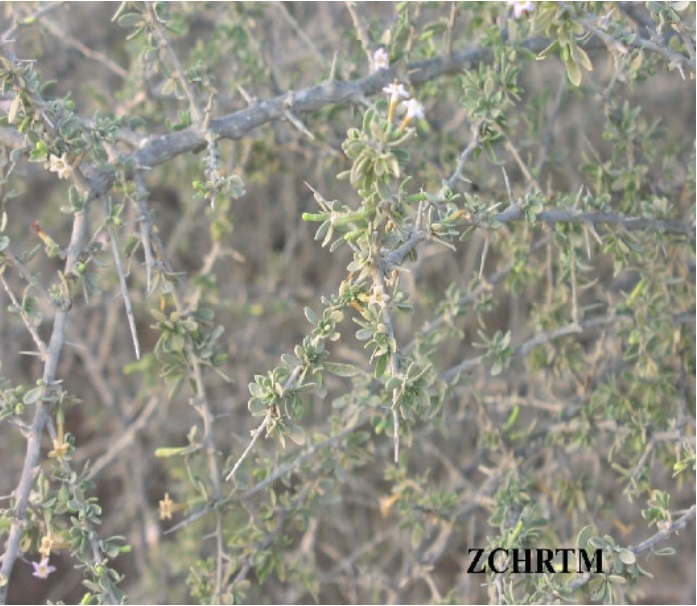
Lycium shawii / عوسج
L. persicum Miers.,L. arabicum Scheweinf ex Boiss.
Awsaj, Ghasad
Desert thorn
Qassad, Awsaj
Solanaceae
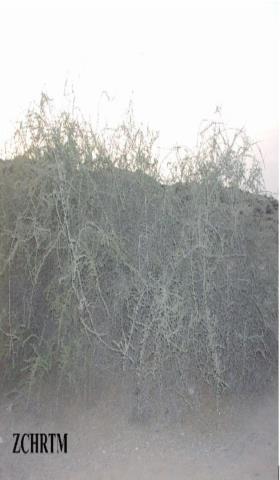
Plant habitat
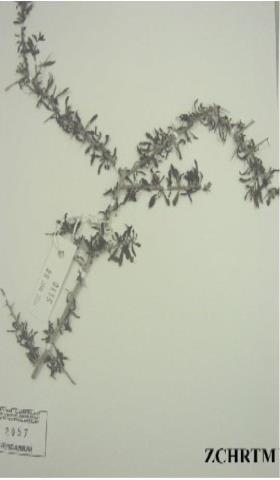
Herbarium Sample
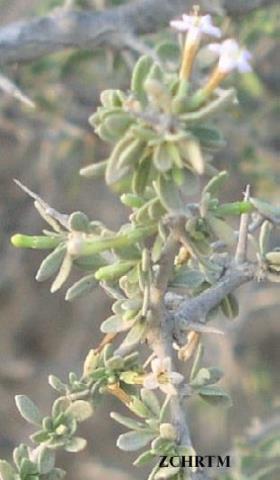
Flowers

Leaves
Ethnobotanical Characteristics
Description
Thorny shrub, very rigid, up to 2 m high. Stems whitish at first but bark on older branches grey-brown, erect with alternative spines , spines 1-3 cm long. Leaves simple, alternate or clustered, sub succulent, grayish green, narrowly obovate to oblong- elliptic, (3-)10-25 mm long x (1-)3-7 mm across, tip obtuse or acute, margin entire, base cuneate, puberulous to tomentose. Flowers solitary or paired in the axils of the leaves, pedicel 1-2(-4) mm long. Calyx persistent, tubular, 10-15 mm long, 5-lobed; lobes unequal, c.1.5 mm long, acute. Corolla white or pale pink to lilac, funnel-shaped,10-15 mm long, 5-lobed; lobes 1-2 mm long, acute, minutely pubescent. Anthers 5, dehiscing longitudinally, held in the mouth of the corolla tube. Ovary 2-locular, style slender, stigma capitate. Fruit a globose berry, c. 4mm in diameter, red, many-seeded. Seeds reniform, compressed, c,1.5 mm across, brown.
Habitat & Distribution
Lycium distributed throughout the tropical regions of the worlds., but most species are concentrated in South America. The genus has about 100 species, 4 of them are recorded in the Arabia, only L. shawii is found in UAE and it is widespread in variety of habitats: alluvial plains, coastal in Ras Al Khaimah, inland in Ajman and Umm al Quwain, mountains, wadis, it is cultivated in farms and roadsides.
Part(s) used
Aerial parts and fruits.
Traditional and Medicinal Uses
Traditionally used to treat many diseases. Decoction of stem laxative and diuretic. Juice of leaves and fruits known to cure jaundice, freckles and skin problems as well as ulcers of mouth and anus, pruritus and infected ear. Fruit edible, laxative, diuretic, antispasmodic and a general tonic, used to improve vision.
Pharmacognosy and Phytochemistry
Parts studied
Leaves and branches
Microscopical description
Leaf: Transverse section of the leaf exhibits its isobilateral character with the palisade tissues found beneath both epidermises. Both upper and lower epidermal cells are oblong or rounded in shape having sinuous irregularly thickened cell walls covered with a thick deep striated cuticle. They contain light green and brown colored particles. The palisade tissue underlying the upper epidermis consists of two layers of oblong cells but shorter cells also exist. The cells have thin slightly wavy cell walls and they contain colored particles. The palisade tissue includes few idioblasts cells slightly collapsed at the middle part and filled with aggregates of prisms. The palisade tissues underlying the lower epidermis have similar characters and they also consist of two layers but of shorter cells. The spongy mesophyll occupies a small zone of oblong or rounded cells rich in large colored particles. It is traversed by vascular tissues including spirally and reticulately thickened vessels. Both epidermises bear numerous long multicellular non-branched and two branched covering trichomes with rod shaped cells together with few glandular trichomes with club shaped heads. The oval anomocytic stomata are numerous on both epidermises and are slightly raised.
Branch: A transverse section shows a circular outline. The outer part consists of few layers of a dark brown bark including thick-walled cork cells filled with brownish pigments. The outer cortex consists of few layers of collapsed cells that contain light brown pigments followed by several layers of compactly packed stone cells. The cortex is divided into many radical zones separated by medullary rays and the zones contain compactly packed phloem and xylem tissues including short fibers, tracheids and vessels which are spirally and scalariformly thickened. The vascular tissues and stone cells are heavily lignified. The pith consists of a brownish yellow zone of oblong to rounded parenchyma cells with thick pitted lignified cell walls (DPS, ZCHRTM unpublished results).
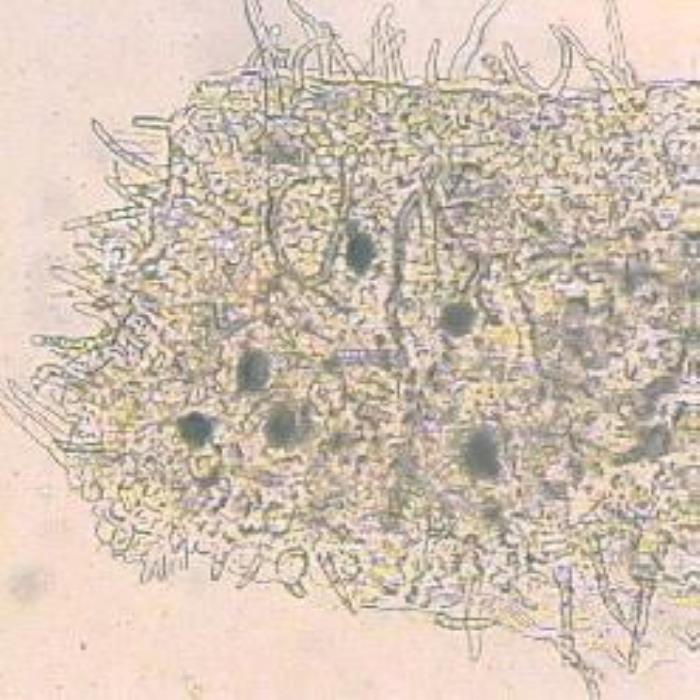
a) TS of the leaf
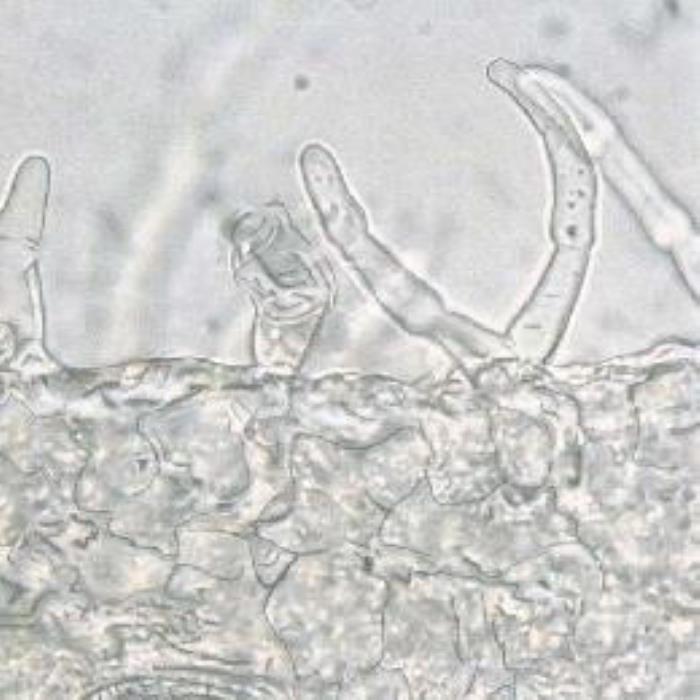
b) Upper epidermis
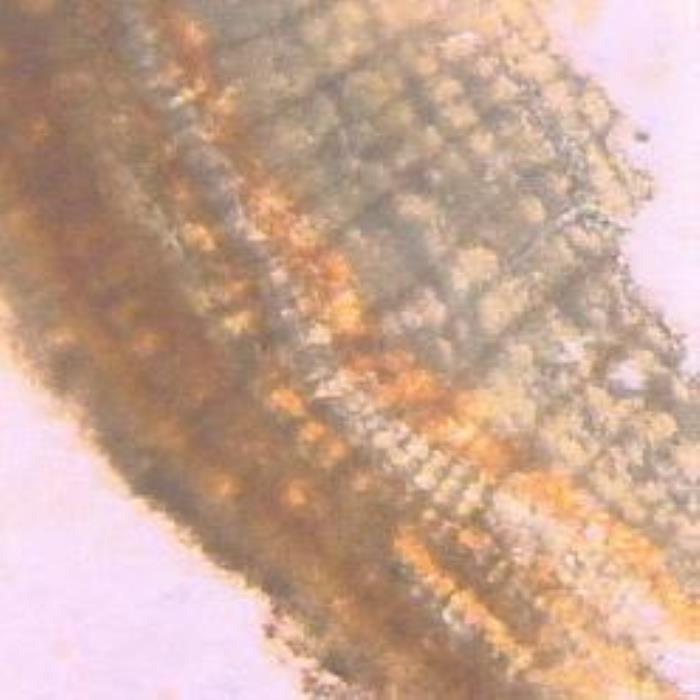
c) Cross section of branch
- (a). TS of the leaf showing general its general features including the upper and lower epidermises, mesophyll enclosing vascular tissues and idioblasts; the epidermises are bearing covering and glandular trichomes.
- (b). TS of the leaf showing the upper epidermis bearing branched and non-branched covering trichomes in addition to a glandular trichome.
- (c). Portion of a cross section of the branch showing from outside to inside: the cork (dark brown), the cortex outer layers (reddish-brown) and the cortex inner layers (gray and yellow) including the vascular tissues. (Magnifications: x 100, x 400 and x 100, respectively).
Organoleptic characteristics
Appearance: Solid powder
Colour: Greyish green
Odour: No specific smell
Taste: Tending sweet
Physicochemical constants
Loss in weight on drying at 105°c (%): 9.40
Solubilities (%)
Alcohol solubility : 1.60
Water solubility: 8.00
Ash values (%)
Total ash: 5.40
Water soluble ash: 2.00
Acid-insoluble ash: 0.30
Successive extractive (%)
Petroleum ether (60-80°c): 1.30
Chloroform: 0.80
Absolute alcohol: 4.20
Distilled water: 8.00
pH values
pH of 1% solution: 6.90
pH of 10% solution: 6.20
The above results are under process of publication (DPS, ZCHRTM unpublished results).
Chemical constituents
The plant contains alkaloids, sterols and terpenes. (Ghazanfar, 1994, DPS, ZCHRTM unpublished results).
Pharmacological and Toxicological studies
Behavioral changes studies showed that ethanolic and chloroform extract of Lycium increased respiration, and mild hyperthermia. The ethanolic extract showed sedation. On the isolated rabbit duodenum, the extract showed mild to moderate contractile effect. On isolated phrenic nerve diaphragm of rat, both extracts caused inhibition of electrically induced contraction of the preparation corroborating the neuromuscular blocking activity (Tariq et. al., 1983,1985). Administration of the extract of Lycium shawii showed transient hypoglycemic effects in rats (Al-Yahaha et. al., 1985). Lycium shawii extract was orally given to normal rats and to alloxanized rats failed to produce antidiabetic activity (Shaban et. al. 1990). The chloroform extract of the plant showed inhibitory action against B. subtilus. Both extracts showed mild toxic to brine shrimp causing 25% death (Al-Yahaha et. al., 1985).The regulation of Lycium barbarum on apoptosis of rat spleen induced by hydrocortisone was studied indicated the plant inhibited the apoptosis induced by HYD and the inhibition is dose dependent (Lu et. al., l999). The plant extract increased the hypoxic tolerance indicating a protective effect on free radical injury caused by hypoxia (Li et. al., 2002).Effects of pure Lycium barbarum polysaccharides on immunological activity were compared with crude plant showed immunomodulatory effect (Luo et. al., l999). The radio-sensitizing effects of the Lycium barbarum polysaccharide were observed by the model transplanted Lewis lung cancer on C57 BL mice showed mild toxicity to the mice (Zhong et. al., 1991).
The pharmacological and toxicological studies carried out in our laboratory and the results in brief, on Lycium shawii (70% ethanolic extract) have been given below. The results presented without references showed unpublished data (unpublished, ZCHRTM, DBMS):
1.) Ethanolic Extract 70%
|
ACTIVITIY |
RESULTS |
|
Effect on Sleeping time- Pentobarbitone sleeping time |
Extract significantly increased latency of sleep time. |
|
Anti-aging activity |
Anti-aging activity presented (Liu et al., 2001; Radha et. al., 2001). |
|
Gross behavioral studies-Tremor/Twitches |
No toxic effect observed. |
|
Gross behavioral studies- Diarrhea, Urination |
No diarrhea found. |
|
Mortality |
No death recorded. |
|
Motor co-ordination (String & Platform test) |
Motor co-ordination not affected. |
|
Acute toxicity studies |
No toxic signs and symptoms observed. |
Summary of the results
The plant extract increased latency of sodium barbitone sleeping time with no severe toxic signs and symptoms on acute toxicity evaluation in mice.
2.) Aqueous extract
|
ACTIVITY |
RESULTS |
|
Anti-inflammatory activity-Rat paw oedema |
Extract failed to show anti-inflammatory activity. |
|
Antinociceptive activity-Hot plate |
Extract failed to show antinociceptive activity. |
|
Antinociceptive activity-Tail flick |
Extract failed to show antinociceptive activity. |
|
Anti-diabetic activity-STZ (Acute) |
Extract did not show anti-diabetic effect. |
|
Anti-diabetic activity-STZ (Subacute) |
Did not show anti-diabetic effect in the animals treated for 14 days. |
|
Anti-diabetic activity-STZ (Subacute) |
Did not show anti-diabetic effect in the animal treated for 31 days. |
|
Anti-hypertension activity-Anesthetic rats |
Transient increased in BP ( Radha et al.,2001). |
|
Locomotor activity |
Produced slight reduction. |
|
Anti-diarrheal activity-Charcoal method |
Decreased gastric motility. |
|
Effect on GIT smooth Muscle-Isolated rat fundus |
Increased in resting tension (Liu et al., 2001). |
|
Effect on Sleeping time-Pentobarbitone sleeping time |
No significant effect on sleeping time observed. |
|
Gross behavioral studies-Tremor/Twitches |
No toxic symptoms. |
|
Gross behavioral studies-Writhing |
No writhing observed. |
|
Gross behavioral studies-Diarrhea, Urination |
No diarrhea observed. |
|
Mortality |
No death recorded. |
|
Motor co-ordination (String &Platform test) |
Motor co-ordination not affected. |
|
Acute toxicity studies |
No toxic effect observed. |
|
LD50 evaluation |
>6.4 g/kg. |
Summary of the results
The plant showed anti-diarrheal activity with no toxic signs and symptoms on acute administration. The plant extract failed to show significant anti-inflammatory activity, analgesic activity and anti-diabetic activity as compared to the controls.
Antimicrobial activity
The chloroform extract of the plant showed inhibitory action against B. subtilus (Al-Yahya et al.1985).
References
- Al-Yaha, M.A. Mossa, J.S. Al-Meshal, I.A., Al-Bader, A.A. Tariq, M. Neuromuscular blocking activity of some Saudi plants.. Proc. 4th Cong. Hangarian Pharmacol. Soc. With international Participation, Budapest, Hungary, August 1985.
- Andrews, F.W. The Flowering Plants of Anglo-Egyptian Sudan: (1950&1952) Vol 1+II; Arbroath, Scotland.
- Department of Biomedical Sciences, Zayed Complex for Herbal Research and Traditional Medicine, unpublished results.
- Department of Pharmacognostic Sciences, Zayed Complex for Herbal Research and Traditional Medicine, unpublished results.
- El-Ghonemy, A. A. (1993) Encyclopedia of Medicinal Plants of the United Emirates. 1st Edition, University of UAE.
- Ghazanfar S A. Handbook of Arabian Medicinal Plants. CRC Press, p.198, 1994.
- Jongbloed, M. V. The Comprehensive Guide to the Wild Flowers of the united Arab Emirates, Erwda, (2003) Emirates Printing Press, Dubai, U.A.E.
- Kotb, T. F. Medicinal Plants in Libya.(1985) Arab Encyclopedia House. Tripoli-Libya.
- Li G, Yang J, Ren B, Wang Z.(2002) Effect of Lycium barbarum L on defending free radicals of mice caused by hypoxia Wei Sheng Yan Jiu.31(1): 30-1.
- Liu, XM., Islam, M.W., Radhakrishnan, R., Chen, HB., Ismail, A. Ali-Naji, M.A. Lycium species: a medicinally important group of plants. The proceeding of International sympsium on Lycium and Anti-aging agents. Organized by The Ningxia Academy of Agriculture & Forestry Sciences and Shanghai Industrial investment Co. Ltd. China. 6-9 August, 2001.
- Lu CX, Cheng BQ. (1991) Radio sensitizing effects of Lycium barbarum polysaccharide for Lewis lung cancer Zhong Xi Yi Jie He Za Zhi. 11(10): 611-2, 582.
- Lu X, Xian X, Lu W, Wu X, Gu H. (1999) The regulation of Lycium barbarum on apoptosis of rat spleen in vitro Zhong Yao Cai. 22(5): 250-1.
- Luo Q, Yan J, Zhang (1999) S.Effects of pure and crude Lycium barbarum polysaccharides on immunopharmacology] Zhong Yao Cai. 22(5): 246-9.
- Mandaville, J. P. Flora of Eastern Saudi Arabia. (1990) Kegan Paul International Ltd. England.
- Miller A.G., Morris M. Plants of Dhofar, The southern Region of Oman: Traditional, Economic and Medicinal Uses.(1987) Office of the Advisor for conservation of the Environment, Sultanate of Oman.
- Radhakrishnan, R., Islam, M.W., Liu, XM, Chen, HB, Ismail, A., Al-Naji, M.A. Lycium species: a medicinally important group of plants. The proceding of International sympsium on Lycium and Anti-aging agents. Organized by The Ningxia Academy of Agriculture & Forestry Sciences and Shanghai Industrial investment Co. Ltd. China. 6-9 August, 2001.
- Shabana MM, Mirhom YW, Genenah AA, Aboutabl EA, Amer HA. (1990) Study into wild Egyptian plants of potential medicinal activity. Ninth communication: hypoglycaemic activity of some selected plants in normal fasting and alloxanised rats. Arch Exp Veterinarmed. 44(3): 389-94.
- Tariq, M., Mosa, J.S. Al-Mesha, I.A., A-Yaha, M.A. Studies on cardio tonic plant of Saudi Arabia. Proc. 43rd Int. Cong. Pharmaceut. Sci. FIP, Montreal, 18, 1983.
- Tariq, M., Mosa, J.S. Al-Mesha, I.A., A-Yaha, M.A. Mossa, J.S. Phytochemical analysis and pharmacological studies on some Saudi plants causing CNS depression, 4th south east Asian/Western pacific Regional Meeting of Pharmacologists., Penang, Malaysia, l985.
- Western, A. R. The Flora of United Arab Emirates, an introduction. (1989) Publication of the UAE University.
